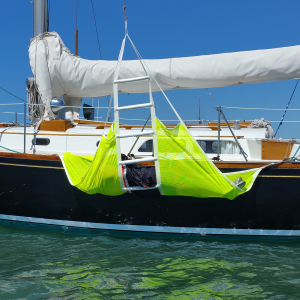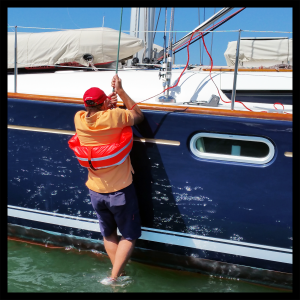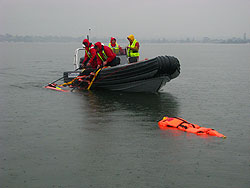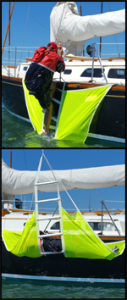
New affordable SOS Marine™ Recovery Ladder™: MOB climbs ladder, or you parbuckle lift (shown)
In this article, we compare MOB recovery gear. Devices vary in ease of use and suitability for a particular rescue. Having the right gear improves odds of rescue. Practice helps too!
A soft device, rather than a swimstep or rigid boarding ladder, reduces chance of injury when the boat rolls.
Some units retrieve non–hypothermic crew by hoisting head first.1 Lifesling and Reelsling are examples of this type of device.
Reelsling comes with 160′ (49m) of floating line, with light reflective strand, for pulling your MOB alongside. It has a built–in sturdy lifting harness for head–first MOB recovery (see photo). This is not recommended for hypothermic crew!

Reelsling flotation doubles as lifting harness
The best MOB recovery systems can safely retrieve hypothermic, disabled, even unconscious crew, who are completely unable to help themselves. An example is Sea Scoopa. The model for powerboat is shown below in a rescue with large inflatable; a sailboat rescue model is shown too.
Professional rescue and life saving organizations will be interested to know that Sea Scoopa is engineered to minimize potential injury to the rescuers doing the lifting.
SAIL magazine editor Charles J. Doane reviewed the Sea Scoopa. He described it as the only unit he had ever used that truly makes it possible to recover an unconscious person from the water without getting in yourself.
He wrote that in July 2012. Almost four years later, Sea Scoopa still sets the standard for MOB retrieval. Especially for commercial, rescue, and military applications, it is ideal. Learn about it. Buy if you can.
If Sea Scoopa is not possible in your program, consider a new product from SOS Marine which has a similar parbuckle–lift feature. This unit is two recovery devices in one. It is both a parbuckle lifting device and a ladder with rungs. It is made of soft, light materials to avoid injuring your MOB during recovery. It’s called, the Recovery Ladder.
Used as a boarding ladder with rungs, able–bodied crew climb aboard at will. Used as a parbuckle lifting device, it halves the load of lifting your disabled or hypothermic overboard crew on board. Note that this parbuckle retrieval requires halyard or block and tackle, not included. The Recovery Ladder, from SOS Marine, is affordable, at under $200.
Get Out of the Water Quickly
There are good reasons to pull an overboard crew out of the water sooner rather than later. The PFDMA tells us that, in water colder than 40° F (4° C), an overboard crew will lose consciousness in 30 minutes or less. That’s quicker than the typical commute to work. Consider this: in those conditions, that crew will die in 30 to 90 minutes.
In water warmer than 80° F (27° C), survival is not immediately threatened. Cold water adds urgency. It demands equipment that is easy to train, easy to use, and works safely and reliably for overboard crew recovery. Many of us are not fortunate enough to do all of our boating in 80° water. What is the sea water temperature now in your area? How long will it take you to find and return to your MOB, then ultimately retrieve the person waiting, praying to be rescued? Professionals train for good reason.
Get Out Quickly, But Sideways is Best
For hypothermic crew, hoisting sideways (horizontally) makes for the safest recovery. This avoids potential fatality, from circum–rescue collapse.
Some overboard recovery devices are not set up to make this recovery. They only lift the MOB vertically, head up. Many people are not aware that this can compromise the hypothermic crew’s survival.
Circum–rescue Collapse Explained
The lower body is compressed by the hydrostatic effect of the water—the so-calledG suiteffect—and blood is diverted upwards into the chest cavity. Blood volume becomes progressively depleted by a physiological reflex causing excessive urination and pulse rate slows as hypothermia develops. Vertical lifting causes immediate loss of theG suiteffect. The already reduced blood volume instantly pools in the lower body and the heart rate cannot increase to compensate for this sudden loss of central blood volume. As a result, circulatory shock and sudden death can occur. This is calledcircum–rescue collapseand is a recognized major hazard of vertical lifting when recovering someone who is hypothermic. For further reading on this, and other medical matters related to marine rescue, consult therescuer’s bible,Essentials of Sea Survival by Golden and Tipton. This text should be in every sea rescue organization's library. –Bob Wright, MD, Director, Intensive Care Services, St. Vincent’s Hospital, Sydney, AUS
Race Requirements for MOB Recovery
The Racing Rules of Sailing includes Fundamental Rule 1.2, which states, A boat shall carry adequate life–saving equipment for all persons on board…
Shown below are minimum specific requirements of sail racing organizations, for man overboard recovery, by section. To safely rescue your (possibly hypothermic) crew:
Evaluate what you need to do to comply with these requirements before your next sail!
From World Sailing OSR
World Sailing publishes Offshore Special Regulations, abbreviated OSR
, which defines a number of race categories referred to below. Section tags below, shown as: § 4.22, refer to the OSR.

- § 4.22 – Crew Overboard Recovery
- For all vessels, all race categories 2, 3
- § 4.22.1 – lifebuoy (dan buoy) with:
- self–igniting light
- drogue
- The dan buoy by SOS Marine complies
- monohulls and multihulls in category 0, 1, or 2 races, see also § 4.22.3
- § 4.22.4 – service intervals
- each inflatable lifebuoy and any automatic device shall be tested and serviced at intervals in accordance with its manufacturer’s instructions
- § 4.22.5 – heaving line
- readily accessible to cockpit
- not less than 6mm (¼″) diameter
- 15 to 25m (50′ – 75′) length
- § 4.22.1 – lifebuoy (dan buoy) with:
- To all of the foregoing, monohulls and multihulls, category 0, 1, 2, or 3 races, add:
- § 4.22.6 – recovery sling with these features:
- 36 metre line
- 20 pounds buoyancy
- strength adequate to lift aboard crew
- The Reelsling complies
- § 4.22.6 – recovery sling with these features:
- To all of the foregoing, monohulls and multihulls, category 0, 1, or 2 races, add:
- in addition to § 4.22.1
- § 4.22.2 – second lifebuoy (dan buoy), with:
- whistle
- drogue
- self–igniting light
- pole and flag
- The SOS Marine dan buoy complies
- See also § 4.22.3
- § 4.22.3 – permanent buoyancy
- one of the lifebuoys shall depend entirely on permanent buoyancy
- the SOS Marine dan buoy can be used for either the § 4.22.1 or § 4.22.2 lifebuoy
- one of the lifebuoys shall depend entirely on permanent buoyancy
- To all of the foregoing, monohulls and multihulls, category 0 races, add:
- § 4.22.2 (c) – flourescein dye packet
- each lifebuoy shall be equipped with a sachet of flourescein dye
- dan buoy has convenient extra attachment point at base
- § 4.22.2 (c) – flourescein dye packet
- For all vessels, all race categories 2, 3
From US Sailing USSER

US SAILING publishes United States Safety Equipment Requirements, abbreviated USSER
, which defines the race classifications below. Section tags below, shown as: § 1.0.1, refer to the USSER.
- Ocean
- (see USSER § 1.0.1)
- …Ocean: Long distance races, well offshore, where rescue may be delayed…
- Coastal
- (see § 1.0.2)
- …Coastal: Races not far removed from shorelines, where rescue is likely to be quickly available…
- Nearshore
- (see § 1.0.3)
- …Nearshore: Races primarily sailed during the day, close to shore, in relatively protected waters…
These sections directly relate to man overboard recovery:
- For all race classifiactions, Ocean, Coastal, and Nearshore
- § 3.7.3 – heaving line
- throwing sock type
- 50′ (15m) length
- floating polypropylene line
- readily accessible to cockpit
- § 3.7.4 – throwable device
- USCG or applicable government approved
throwable device
- If device carried to satisfy § 3.7.1 or § 3.7.2 satisfies this requirement, then no additional device is needed
- USCG or applicable government approved
- § 3.7.3 – heaving line
- For Ocean and Coastal races
Additional Resources
We have an FAQs page on man overboard recovery.
Footnotes
1For information about hypothermia, also see World Sailing OSR Appendix J
2Read overview of World Sailing race categories, 0, 1, 2, 3, 4, 5, and 6.
3Except category 5 races, for which see OSR Appendix B; for category 6 races, see OSR Appendix C




I think that is one of the so much significant information for me.
And i am glad studying your article. However wanna statement on some
basic things, The site taste is wonderful, the articles
is in reality nice : D. Just right task, cheers